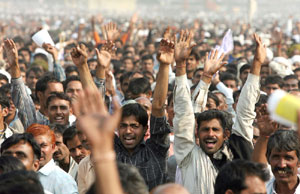

Vol. 71/No. 44 November 26, 2007

|
| Tauseef Mustafa/Stringer |
| Peasants rally November 3 in New Delhi following 26-day march from the central city of Gwalior to demand land reform. Hundreds of thousands of subsistence farmers have been dispossessed by capitalists and landlords in recent years. |
Rural workers from 18 of India’s 29 states marched on the capital. They included newly landless peasants as well as long-dispossessed toilers such as dalits (so-called untouchables) and members of indigenous tribes known as adivasis.
Organizers called for “a national authority to oversee land reform and a system of fast track courts to deal with the long delays in resolving land disputes,” the BBC reported. The protest was organized by the United Forum, which describes itself as a Gandhian organization.
Capitalists and landlords, backed by government authorities, have driven hundreds of thousands of subsistence farmers off their land in recent years. The government has established “Special Economic Zones” offering tax breaks to set up factories and businesses, which has accelerated the dispossession of peasants.
Farmers protested bureaucratic obstacles to the resolution of land disputes, and politicians who swindle rural toilers into giving up their land for a pittance.
As the marchers arrived in New Delhi, two people were shot at a demonstration in West Bengal against plans to dispossess peasants living on 9,000 acres of land to build a chemical plant.
A large deployment of cops detained marchers in a gated area in the city and blocked them from reaching the parliament building. “The city’s police force had instructions to keep the capital spruce for visiting dignitaries,” reported the Financial Times, “among them Angela Merkel, the German chancellor, Henry Paulson, U.S. Treasury secretary, and dozens of chief executives in town for a lavish conference” organized by Fortune magazine.
The day after the marchers arrived, newspapers were flooded with the news that Mumbai’s Sensex stock market index had hit a new high of 20,000. “The first 10,000 took over 20 years. The next came in just 20 months. Superpower 2020?” gushed the front-page headline of the Economic Times.
While a tiny minority of wealthy families have benefited from India’s economic boom, conditions for the vast majority in city and countryside have worsened.
Some 72 percent of India’s 1.1 billion people live in rural areas. More than 400 million people lack access to electricity, especially in the countryside. The World Bank estimates that 600 million cook with wood and other forms of “biomass” while 275 million depend at least partially on food, forage, fuel, and other products collected in the dwindling forest lands.
Front page (for this issue) |
Home |
Text-version home